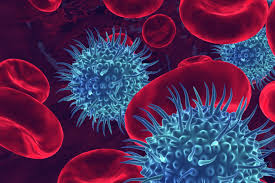Immunity refers to the body’s ability to prevent the invasion of pathogens
Pathogens are foreign disease-causing substances, such as bacteria and viruses, and people are exposed to them every day.
Antigens are attached to the surface of pathogens and stimulate an immune response in the body.
An immune response is the body’s defense system to fight against antigens and protect the body.
Table of Contents
ToggleTypes of immunity
- Innate immunity
- Acquired (adaptive) immunity
- Passive immunity
1. Innate immunity
It is the general protection that a person is born with.
Including physical barriers (skin, body hair), defense mechanisms (saliva, gastric acid), and general immune responses (inflammation). This type of immunity is considered non-specific defense mechanisms.
Although the immune system does not know exactly what kind of antigen is invading the body, it can respond quickly to defend against any pathogen.
Types of innate immunity
- First line of defenses
- Second line of defenses
First line of defenses/external/physical/ barrier defenses
- The stratum corneum of the epidermis of the skin is non-living, and when unbroken is an excellent barrier to pathogens of all kinds.
- The fatty acids in sebum help limit the growth of bacteria on the skin. The living cells of the epidermis produce defensins, which are antimicrobial chemicals.
- The mucous membranes of the respiratory, digestive, urinary, and reproductive tracts are living tissue, yet still a good barrier.
- The ciliated epithelium of the upper respiratory tract is an especially effective barrier. Dust and pathogens are trapped on the mucus, the cilia sweep the mucus to the pharynx, and it is swallowed.
- The hydrochloric acid of the gastric juice destroys most pathogens that enter the stomach, either in mucus or with food and drink.
- Lysozyme, an enzyme found in present in saliva, perspiration, nasal secretions, and tissue fluids inhibit the growth of bacteria in the oral cavity and on the warm, wet surface of the eye.
- One way flow of urine through the urethra to the exterior prevents the ascending microorganisms.
- The lacrimal apparatus of the eyes manufactures and drains away tears in response to irritants.
- Blinking spreads tears over the surface of the eyeball, and the continual washing action of tears helps to dilute microbes and keep them from settling on the surface of the eye. Tears also contain
lysozyme, an enzyme capable of breaking down the cell walls of certain bacteria. - Saliva, produced by the salivary glands, washes microbes from the surfaces of the teeth and from the mucous membrane of the mouth, much as tears wash the eyes. The flow of saliva reduces
colonization of the mouth by microbes. - Defecation and vomiting also expel microbes. For example, in response to some microbial toxins, the smooth muscle of the lower gastrointestinal tract contracts vigorously; the resulting diarrhea rapidly expels many of the microbes.
- The acidity of the skin (pH 3–5) is caused in part by the secretion of fatty acids and lactic acid.
- Perspiration helps flush microbes from the surface of the skin.
- Gastric juice, produced by the glands of the stomach, is a mixture of hydrochloric acid, enzymes, and mucus. The strong acidity of gastric juice (pH 1.2–3.0) destroys many bacteria and most bacterial toxins.
- Vaginal secretions also are slightly acidic, which discourages bacterial growth and Vaginal secretions likewise move microbes out of the body in females.
Second line of defense’s (internal defenses)
When pathogens penetrate the physical and chemical barriers of the skin and mucous membranes, they encounter a second line of defense which include the following:
1. Internal/Natural anti-microbial substances;
- Interferons: (alpha-, beta-, and gamma-interferons) are proteins produced by cells infected with viruses and by T cells to prevent virus reproduction.
- Complement: is a group of more than 20 plasma proteins that circulate in the blood until activated, it is involved in the lysis of cellular antigens and the labeling of non-cellular antigens and stimulate the release of histamine.
- Iron-binding proteins: inhibit the growth of certain bacteria by reducing the amount of available iron. Examples include transferrin (found in blood and tissue fluids), lactoferrin (found in milk, saliva, and mucus), ferretin (found in the liver, spleen, and red bone marrow), and hemoglobin (found in red blood cells).
- Antimicrobial proteins (AMPs): are short peptides that have a broad spectrum of antimicrobial activity. Examples of AMPs are dermicidin (produced by sweat glands), defensins and cathelicidins (produced by neutrophils, macrophages, and epithelia), and thrombocidin
(produced by platelets).
2. Defensive cells:
- Phagocytes e.g. Macrophages (fixed and wandering), dendritic cells e.g. Langerhans cells: they carry out phagocytosis, Neutrophils ( When
the body is injured or invaded by a pathogen, neutrophils are rapidly produced and move to the site of the insult to attack the foreign substance. Because neutrophils are able to engulf and digest foreign material, they are called phagocytes.) - Eosinophils: Eosinophils are circulating myelocytic leukocytes whose exact
function is not understood. They are often found at the site of allergic reactions and may be responsible for removing the proteins and active components of the immune reaction from the site of an allergic response. - Basophils: Basophils are myelocytic leukocytes that are not capable of phagocytosis. They contain chemical substances or mediators that are important for initiating and maintaining an immune or inflammatory response. These substances include histamine, heparin, and other chemicals used in the inflammatory response.
- Mast cells: These are basophils that are fixed and do not circulate. . They are found in the respiratory and GI tracts and in the skin. They release many of the chemical mediators of the inflammatory and immune responses when they are stimulated by local irritation
3. Inflammation;
This is the physiological response to tissue damage and is accompanied by a characteristic series of local changes.
Its purpose is protective: to isolate, inactivate and remove both the causative agent and damaged tissue, so that healing can take place.
The cardinal signs of inflammation are
- Redness: Redness is as a result of increased blood flow.
Following injury, both the arterioles supplying the damaged area and the local capillaries dilate, increasing blood flow to the site. This is caused mainly by the local release of a number of chemical mediators from damaged cells, i.e. Histamines, Kinins, Prostaglandins, e.t.c. - Heat: It occurs as a result of an endogenous pyrogen (interleukin 1) which is released from macrophages and granulocytes in response to microbial toxins or immune complexes. Interleukin 1 is a chemical
mediator that resets the temperature thermostat in the hypothalamus at a higher level, causing pyrexia and other symptoms that may also accompany systemic inflammation, e.g. fatigue and loss of appetite.
The increased temperature of inflamed tissues has the twin benefits of inhibiting the growth and division of microbes, whilst promoting the activity of phagocytes. - Swelling: It is as a result of fluid leaving local blood vessels and entering the interstitial spaces i.e. Plasma proteins, normally retained within the bloodstream, also escape into the tissues through the leaky capillary walls; this increases the osmotic pressure of the tissue fluid and draws more fluid out of the blood.
- Pain: This occurs when local swelling compresses sensory nerve endings. It is exacerbated by chemical mediators of the inflammatory process, e.g. bradykinin and prostaglandins which potentiate the
sensitivity of the sensory nerve endings to painful stimuli. Although pain is an unpleasant experience, it may indirectly promote healing, because it encourages protection of the damaged site.
4. Immunological surveillance; see IMMUNOLOGY for details.

2. Acquired (adaptive) immunity
It is a type of immunity that develops from immunological memory.
The body is exposed to a specific antigen (which is attached to a pathogen) and develops antibodies to that specific antigen.
It is referred to specific defense mechanisms or active immunity.
The next time said antigen invades; the body has a memory of the specific antigen and already has antibodies to fight it off.
Acquired immunity can occur from exposure to an infection, wherein a person gets a disease and develops immunity as a result.
Acquired immunity also occurs from vaccination wherein the vaccine mimics a particular disease, causing an immune response in the vaccinated individual without getting them ill.
Types of adaptive (active) immunity
There are two types of adaptive (active) immunity:
- Naturally acquired (active) immunity
- Artificially acquired (active) immunity.
Naturally Acquired (active) Immunity.
The body manufactures antibodies after the exposure to an infection or sub infection naturally and is exemplified by an individual who is exposed to chickenpox for the first time and who has no immunity to the disease. The body immediately begins to manufacture antibodies against the chickenpox virus.
However, the production of a sufficient quantity of antibodies takes time, and the individual gets the disease. At the time of exposure and while the individual still has chickenpox, the body continues to manufacture antibodies. These antibodies circulate in the individual’s blood stream for life. In the future, any exposure to the chickenpox virus results in the antibodies mobilizing to destroy the invading antigen.
Artificially Acquired Active Immunity
Artificially acquired active immunity occurs when an individual is given a killed or weakened antigen, which stimulates the formation of antibodies against the antigen. The antigen does not cause the disease, but the individual still manufactures specific antibodies against the disease. When a vaccine containing a live attenuated (weakened) antigen is given, the individual may experience a few minor symptoms of the disease or even a mild form of the disease, but the symptoms are almost always milder than the disease itself and usually last for a short time.
3. Passive immunity
It is the body’s capacity to resist pathogens by “borrowing” antibodies.
For example, antibodies can be transferred to a baby from a mother’s breast milk, or through blood products containing antibodies such as immunoglobulin that can be transfused from one person to another.
The most common form of passive immunity is that which an infant receives from its mother. Antibodies are transported across the placenta during the last one to two months of pregnancy. As a result, a full-term infant will have the same antibodies as its mother. These antibodies will protect the infant from certain diseases for up to a year, and act to defend against specific antigens. Although beneficial, passive immunity is temporary until the antibodies are gone (wane), since the body has not produced the antibodies.
Types of passive immunity
- Passive naturally acquired immunity: This type of immunity is acquired before birth by the passage of maternal antibodies across the placenta to the fetus, and to the baby in breast milk. The variety of different antibodies provided depends on the mother’s active immunity. The baby’s lymphocytes are not stimulated and this form of immunity is short lived.
- Passive artificially acquired immunity: In this type, ready-made antibodies, in human or animal serum, are injected into the recipient. The source of the antibodies may be an individual who has recovered from the infection, or animals, commonly horses, that have been artificially actively immunized. Specific immunoglobulins (antiserum)
may be administered prophylactically to prevent the development of disease in people who have been exposed to the infection, e.g. rabies, or therapeutically after the disease has developed.



Interesting and enjoyable for sure